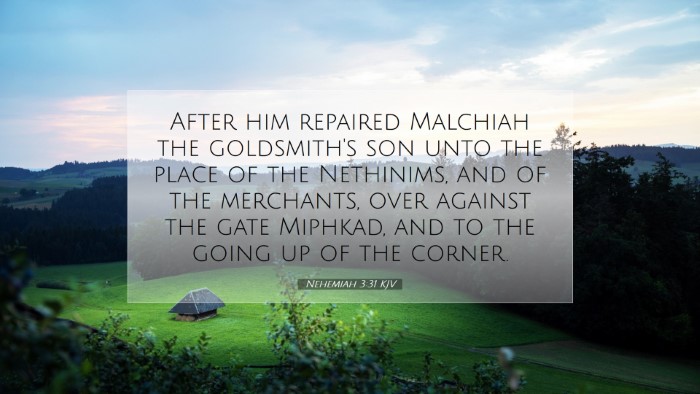Commentary on Nehemiah 3:31
Nehemiah 3:31 states, "After him repaired Malchiah the goldsmith's son unto the place over against the house of the Nethinims, and that of the merchants, over against the gate Mipham." This verse concludes a detailed account of the cooperative efforts in rebuilding the walls of Jerusalem. In this commentary, we will explore the significance of this verse through various insights drawn from esteemed public domain commentaries.
Contextual Background
The Book of Nehemiah narrates the story of the return of the Jewish exiles from Babylon. Under Nehemiah's leadership, the Israelites undertook the monumental task of rebuilding the walls of Jerusalem, which had been broken down during the Babylonian conquest. Chapter 3 particularly focuses on the contributions made by various groups and individuals involved in this endeavor.
Insights from Commentators
Matthew Henry’s Commentary
Matthew Henry emphasizes the collective nature of the rebuilding project. In his commentary, he observes that the repairs were made by a diversity of people from various backgrounds, indicating unity and collaboration among the Jews. He notes that Malchiah, being a goldsmith, symbolizes the blending of spiritual and practical contributions to the restoration of Jerusalem.
Henry further points out that Malchiah's repair work is located in a significant area, "the place over against the house of the Nethinims." This reference suggests a recognition of all societal classes in the effort to restore the city, highlighting that both common laborers and priestly families participated in this work.
Albert Barnes’ Notes
Albert Barnes provides insight into the specific roles and responsibilities assigned to different individuals in the rebuilding effort. He draws attention to the fact that the work was not just the responsibility of the leaders; rather, every class of society, including tradesmen like Malchiah, was involved.
Barnes interprets the phrase “over against the house of the Nethinims” as indicative of the social fabric of the community. The Nethinims were temple servants who were set apart for particular duties. Their proximity to the merchants illustrates the interdependent relationship of different groups working toward a common goal.
Adam Clarke's Commentary
Adam Clarke adds depth to this analysis by focusing on the specific terms used, such as "goldsmith’s son." He underscores the idea that each person, regardless of their profession, was crucial to the work of rebuilding the walls of Jerusalem. Clarke helps to highlight that the rebuilding of the city was a communal responsibility.
Moreover, Clarke suggests that the mention of "the merchants" signifies the economic aspect of the city’s revival. Rebuilding the walls was not simply about physical restoration but involved revitalizing trade and ensuring safety for commercial activities. This reflects a holistic approach in the work of Nehemiah.
Theological Implications
The efforts described in Nehemiah 3:31 provide rich theological insights. The cooperative nature of the rebuilding resonates with the unity of the Body of Christ, where every member, regardless of societal status, contributes to the health and mission of the church. This verse serves as a reminder to all believers about the importance of collaboration in fulfilling God’s work.
The Importance of Service
The participation of a goldsmith in a construction project reinforces the message that no task is too insignificant when done in God's name. Each role, whether high or low, contributes to the overall mission, reflecting the principle found in 1 Corinthians 12:12-27, where Paul emphasizes that each part of the body is essential.
Restoration and Hope
This passage illustrates the theme of restoration which runs throughout Scripture. Nehemiah's leadership and the community's response show that hope can be rekindled even after destruction. This serves as an encouraging message for pastoral and theological reflection, underscoring that God can restore and rebuild our lives and communities as we work together.
Conclusion
Nehemiah 3:31 encapsulates the spirit of teamwork, diverse participation, and the hopeful restoration of God’s people. The combined insights from Matthew Henry, Albert Barnes, and Adam Clarke paint a picture of a community coming together in faith and action. For pastors, scholars, and students, it serves as both an encouragement and a challenge to engage collectively in the mission of building God’s kingdom, reflecting on our unique roles while fostering unity in diversity.


